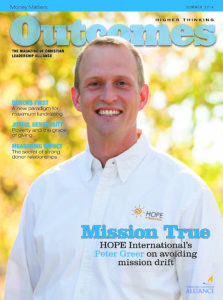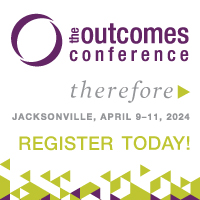
Mission True: Talking Leadership with Peter Greer
 An interview with Peter K. Greer
An interview with Peter K. Greer
CLA president and CEO Tami Heim recently interviewed Peter Greer, president and CEO of HOPE International.
HOPE International is a network of microfinance institutions and savings and credit associations operating in 17 nations worldwide. HOPE empowers men, women, and families to break cycles of physical and spiritual poverty through discipleship, biblically based business training, savings services, and small loans.
Greer is the co-author of The Poor Will Be Glad (Zondervan, 2009), The Spiritual Danger of Doing Good (Bethany House Publishers, 2013), and Mission Drift(Bethany House Publishers, 2014).
What started your focus on mission drift, ultimately leading to your new book?
Several years ago I was in Houston meeting with a foundation. They were enthusiastic about HOPE International’s microfinance model, and were considering a significant funding proposal. At the end of our conversation they had just one additional point: as a publicly traded company they had concerns about HOPE’s overtly Christ?centered identity. They said that if we were willing to tone that down they could come alongside us financially in a much more significant way.
Many nonprofit leaders will understand how having someone say “I’ve got a big check if you’re willing to do that,” can be tempting. We asked ourselves, “Is it possible for us to receive this funding and still do our whole mission?” We discussed it with our board and leadership team. That started a broader conversation about our core mission. We asked, “What small decisions will bring us closer alignment with who we are and what we’re called to do, and what small decisions will slowly and gradually pull us away?” We decided that we couldn’t take that money, as it would cause us to drift from our mission.
Mission Drift shares insights from organizations, known for excellence and tremendous impact, that have remained mission true.
This edition of Outcomes is themed “Money Matters.” How much does money contribute to mission drift?
In our book, we looked at Christian nonprofits that fell prey to mission drift. It was never just one thing that led there. It was not just money. It was not just the board. It was not just leadership. It was not just culture. It was a myriad of small decisions compounded over time that led organizations to a very different place.
To remain mission true, the key is to have your eyes wide open for drift. You then have to make hard, sometimes painful, decisions to stay on mission. That’s what we did after that meeting in Houston when we decided to accept short?term pain, refusing a generous funding offer if it required that we talk less about our Christ?centered identity.
Organizations that remain mission true are diligent about small decisions, on staffing, on funding, and more. It is the cumulative impact of a lot of small decisions that keeps you on mission or gradually causes you to drift away.
What are some practical ways of addressing mission drift when you see it happening?
I’ll give you an example. Previously, a presentation on HOPE International might have focused on growth we’ve experienced or the number of families we’ve served. We’ve changed that. We still care about and measure those things, but we talk about our identity first. We talk about doing our model, with excellence second.
Growth is not a leading indicator; it’s a lagging indicator. We want to lead with our Christ?centered identity. It is why we do our work with excellence.
The second thing that we learned is that we needed to be more diligent in how we recruited board members. We are blessed with a fantastic board, but in the past we did not have the right process in place to screen board members to ensure they were fully in line with our mission.
A third thing is that although we screened well for staff, once they came on board we didn’t have a sufficient process to support their spiritual health and growth. Today we have a department at HOPE making sure discipleship and outreach happens at every level of the organization. We have a director of spiritual integration on our executive team who makes sure that outreach and discipleship is not peripheral, but at the very heart of everything that we do.
What are the biggest challenges for organizations in maintaining Christian distinctiveness in today’s world?
When you look at organizations that have drifted, you see stories of founders who were passionate about the gospel and the Christian mission. But it’s a mistake to think that the founder’s story, the passion of the original team, will never be lost. If you’re not diligent about protecting your mission, the tug of secularization will cause you to drift. The biggest challenge is to have our eyes open to realize that this could happen to any organization.
Most of us have strategic plans that last one, two, three, or five years at most. Very few organizations have a plan that says in 50 years or 100 years, long after we’re all gone, here is what we hope will remain. Even at Christian Leadership Alliance, if you don’t combine your name, founding vision, and mission with a high degree of intentionality to reinforce that identity, there is no guarantee that in 50 years you’re going to be doing what the organization was created to do.
What about the roles of the CEO and board in keeping an organization on mission?
The board is the guardian of the mission. Certainly there is a fiduciary responsibility and the approval of resource allocation. There is the selection of the CEO. But those roles are subordinate to making sure that the organization is doing what it was created to do.
Let’s think practically. What is the focus when your ministry board gathers? Is it all about strategic decisions, growth, and expansion? Is it all about the budget? Or are there conversations around how the organization is remaining mission true? Is the CEO evaluated not only about growth and budget, but also about whether the organization has a vibrant mission true culture?
A lack of corporate prayer is another key mission-drift indicator. If at board meetings there are so many important topics to discuss that you can’t stop and pray about those topics, it’s an indicator of a lack of intentionality about remaining mission true.
Mission true organizations know who they are and why they exist. They filter all decisions through that lens. It’s not saying the methods don’t change, that means don’t change, but the core purpose of the organization remains.
What key insight do you hope nonprofit leaders will take away from the book?
We hope it will equip leadership teams, boards of directors, and staffs to ask whether their decisions are bringing greater alignment with their organization’s mission or gradually bringing them to a different place.
We only see the impact of our decisions long-term. It’s the vector principle. Being one degree off when you’re going 100 yards doesn’t make much difference. But if you’re going across the country, one degree off will take you to an entirely different place.
We also created a mission drift survey available at (missiondriftbook.com). It has been interesting to see where organizations are in terms of their susceptibility to drift. Our goal is to help leaders and organizations remain mission true.
###
This is an excerpt from the Summer 2014 edition of CLA’s Outcomes Magazine.
Don’t Miss out!
June 30,2014 is your last chance to take advantage of the best savings of the year for

What is Christian Leadership Alliance?
Christian Leadership Alliance equips and unites leaders to transform the world for Christ. We are the leaders of Christ-centered organizations who are dedicated to faithful stewardship for greater kingdom impact.
Sign up for FREE blog updates.
Upcoming Events
Check back later!




